Table of Contents

Pavement damage can be costly and disruptive, but catching issues early can save you time and money in the long run. Knowing how to spot early signs of pavement damage is crucial. In this blog, we’ll explore key indicators of pavement issues and provide actionable tips to help you maintain your pavement effectively.
Understanding Pavement Damage
Pavement damage can occur due to various factors including weather conditions, heavy traffic, and poor maintenance. Early detection of damage allows for timely intervention, which can prevent more severe problems and extend the life of your pavement.
Common Causes of Pavement Damage
Before diving into the signs of damage, it’s essential to understand what causes pavement deterioration:
- Weather Conditions: Extreme temperatures, rainfall, and freeze-thaw cycles can cause cracks and potholes.
- Heavy Traffic: Frequent use, especially by heavy vehicles, can lead to wear and tear.
- Poor Drainage: Water accumulation can weaken the pavement’s base and surface.
- Material Degradation: Over time, pavement materials can break down due to UV exposure and chemical reactions.
Early Signs of Pavement Damage
Spotting damage early involves being vigilant about the condition of your pavement. Here are some key indicators to watch for:
Cracks
Types of Cracks:
- Hairline Cracks: These are usually minor and can be caused by surface shrinkage.
- Surface Cracks: These are larger and can result from weathering or minor structural issues.
- Structural Cracks: Deep and wide cracks often signal more severe problems with the pavement’s integrity.
What to Look For:
- Cracks that are widening or deepening.
- Cracks with jagged edges.
- Cracks that allow water penetration.
Potholes
Pothole Characteristics:
- Circular depressions or holes in the pavement surface.
- Visible damage around the edges, such as peeling or loose material.
Causes and Risks:
- Potholes are often caused by water infiltration and freeze-thaw cycles.
- They can be hazardous, causing vehicle damage and safety concerns.
Surface Erosion
Signs of Erosion:
- Wearing away of the pavement surface.
- Loss of aggregate material, resulting in a rough texture.
Impact of Erosion:
- Erosion weakens the pavement surface and can lead to further deterioration.
Fading or Discoloration
Possible Causes:
- UV damage or chemical spills can cause discoloration.
- Uneven fading may indicate underlying issues with the pavement.
Implications:
- Fading can affect the aesthetic appeal and might be a sign of material degradation.
Alligator Cracking
Identification:
- A pattern of interconnected cracks resembling an alligator’s skin.
- Typically found in areas subjected to heavy traffic or poor drainage.
Consequences:
- Alligator cracking indicates significant structural problems and may require major repairs.
How to Address Pavement Damage
Once you’ve identified signs of damage, it’s essential to take prompt action to address the issues.
Routine Inspections
Frequency and Tips:
- Conduct visual inspections every few months, especially after severe weather.
- Look for early signs of damage and address them immediately to prevent escalation.
Regular Maintenance
Maintenance Practices:
- Sealing Cracks: Use crack filler or sealant to prevent water infiltration and further damage.
- Resurfacing: Apply a new layer of pavement or seal coat to restore surface integrity and appearance.
- Cleaning: Keep the surface clean and free from debris, which can contribute to deterioration.
Professional Assessments
When to Seek Help:
- If you notice severe or extensive damage.
- For expert advice on repair and maintenance strategies.
Benefits of Professional Services:
- Accurate diagnosis of underlying issues.
- High-quality repairs and long-term solutions.
Preventative Measures to Extend Pavement Life
Implementing preventative measures can reduce the risk of damage and extend the life of your pavement.
Proper Drainage
Solutions:
- Ensure proper grading and drainage systems are in place.
- Regularly clear drains and gutters to prevent water accumulation.
Weight Management
Guidelines:
- Avoid parking heavy vehicles on pavement surfaces.
- Use weight limits to prevent excessive stress on the pavement.
Regular Cleaning and Inspection
Best Practices:
- Regularly clean the surface to prevent the buildup of harmful substances.
- Schedule periodic professional inspections to identify and address potential issues early.
Conclusion
Spotting early signs of pavement damage is essential for maintaining the safety, functionality, and appearance of your pavement. By being vigilant and taking prompt action, you can prevent minor issues from escalating into costly problems. Regular inspections, routine maintenance, and professional assessments are key to extending the life of your pavement and ensuring its optimal performance.
For more tips and expert advice on pavement care, call us at 844-777-7924. Royal Pavement Solutions can help you with all of your pavement needs. If you need professional assistance, contact us today to schedule an inspection or discuss your pavement needs.

